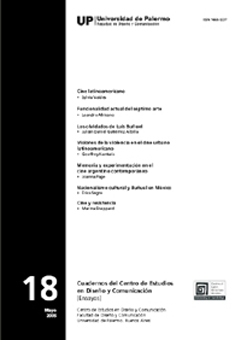Cine y resistencia
Abstract
The relationship between Cinema and Politic in Latin America has changed considerably since the New
Latin American Cinema of the 1960s and 1970s. The changing political powers, neo liberalism and different
professional practises of feature filmmaking leave little space for revolutionary visions. Referring to some
ideas on Resistance, Utopia and Ideology from Frederic Jamesons Signatures of the Visible and Gene
Sharps The Politics of Nonviolent Action this article explores how a number of contemporary films continue to use cinema as an agent of non-violent political resistance. Cinema in most Latin American countries engages less openly and radically with politics at the turn of the millennium. It is multifaceted, less
dogmatic and often more entertaining. There is a trend towards more personal stories, which reflect the
facts of society in a subtle and lively way that can implement a radical political meaning without explicitly
articulating their message. Nowadays Heroes can be ambivalent, fractured and therefore more human and
perhaps more empathetic.
References
Jameson, Frederic (1992).The Geopolitical Aestethics, London bf.
Jameson, Frederic (1979). Reification and Utopia in Mass Culture 1979 in Jameson Frederic Signatures of
the Visible London Routledge.
Koch, Johan et al (2002). Strukturalismus Zur Geschichte und Aktualitat eines kulturwissenschaftlichen
Paradigmas Heidelberg Synchron.
Sharp, Gene (1973). The Political Nonviolent Action Boston Porter Sargent.
Referencias (films)
Golpe de Estad(i)o. Sergio Cabrera. Colombia. 1998.
La vendedora de rosas .Victor Gaviria. Colombia. 1998.
Danzón. María Novaro. México. 1991.
Fresa y chocolate. Tomás Gutiérrez Alea y Juan Carlos Taibo. Cuba. 1993.
Historias de la Revolución .Tomás Gutiérrez Alea. Cuba 1960.
Memorias del subdesarrollo. Tomás Gutiérrez. Alea Cuba. 1968.
La Hora de los Hornos. Fernando Solanas. Argentina. 1968.
El Viaje. Fernando Solanas. Argentina. 1992.
Sur. Fernando Solanas. Argentina. Tango: El exilio de Gardel . Fernando Solanas. Argentina. 1985.
Dios negro Diablo blanco .Glauber Rocha. Brasil .1963-64.
Amor mujeres y flores. Marta Rodríguez. Colombia. 1998.
Nunca más . Marta Rodríguez. Colombia. 2001.
La estrategia del caracol .Sergio Cabrera. Colombia. 1993
Rodrigo D. No futuro. Victor Gaviria. Colombia. 1990.
Sin dejar huella. Maria Novaro. México. 2000.
Los autores/as que publiquen en esta revista ceden los derechos de autor y de publicación a "Cuadernos del Centro de Estudios de Diseño y Comunicación", Aceptando el registro de su trabajo bajo una licencia de atribución de Creative Commons, que permite a terceros utilizar lo publicado siempre que de el crédito pertinente a los autores y a esta revista.


